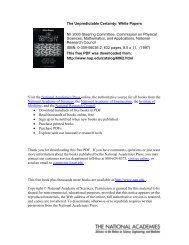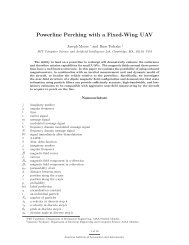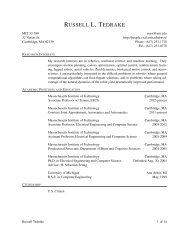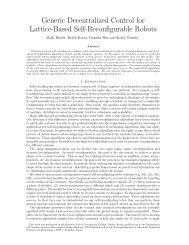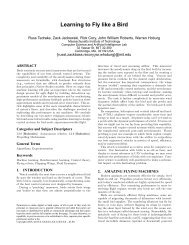Online Social Networks and E-Commerce - MIT Computer Science ...
Online Social Networks and E-Commerce - MIT Computer Science ...
Online Social Networks and E-Commerce - MIT Computer Science ...
You also want an ePaper? Increase the reach of your titles
YUMPU automatically turns print PDFs into web optimized ePapers that Google loves.
Require Business to Draft Protection Plan<br />
Clarence Lee <strong>and</strong> Shirley Fung<br />
We propose that a similar plan to the Safeguard Rule to be applied to third party Web sites. This<br />
establishes a st<strong>and</strong>ard requiring all Web sites having to store user information to comply. In addition, the<br />
major benefit of an established system such as this is to help consumers underst<strong>and</strong> the steps taken to<br />
protect their data.<br />
Establish Enforcement Authority<br />
Lastly, the most important part of our proposal is to establish enforcement authority. While enacting<br />
GLBA enforcement structure for our proposal would be a big step forward for protecting online customer<br />
privacy, we feel that there is a way that the enforcement authority could be enhanced.<br />
The biggest problem with the GLBA enforcement structure is that it places the burden of enforcement<br />
entirely on the Federal Government. We recommend that the state government to have to power of<br />
enforcement as well. While one may contest this notion by pointing out the fact that a particular Web site<br />
may store user data from all 50 states, such ambiguity could be enforced by the state in which the Web<br />
site’s creators reside in. Similar to how the United States Court Circuit alleviate burden off the Supreme<br />
Court, this method will alleviate the Federal Government’s burden of enforcing this accountability<br />
structure in all fifty states.<br />
Conclusion<br />
Unlike ten years ago, the Internet has grown to be a common household commodity. <strong>Social</strong> networking<br />
sites <strong>and</strong> e-commerce sites has enjoyed a period of immense growth. As the popularity of these Web<br />
sites increase, the gap between our virtual life on the Internet <strong>and</strong> our real life in the physical world<br />
becomes smaller <strong>and</strong> smaller. As a result, we must reexamine whether the privacy policies implemented<br />
years ago should be updated in order to keep up with the incredible progress of technology.<br />
For this paper, we examined two types of Web sites: e-commerce Web sites <strong>and</strong> social network Web sites.<br />
The combination of both makes up a significant portion of Web traffic. In addition, we looked at two<br />
specific examples: Amazon <strong>and</strong> Facebook, <strong>and</strong> we examined the types of user information that is stored<br />
on both.<br />
Due to the massive amount of personal data stored on both of these Web sites, we proposed two solutions<br />
to ensure consumer privacy protection. The first is to require a blanket protection policy to protect<br />
private data from government intrusion. Given that the type of data on these Web sites can tell someone a<br />
lot of a user, a blanket protection policy is needed to protect all data so one cannot circumvent the system<br />
by acquiring information in a less protected category.<br />
Page 35




![[ti]The “Vulgar Spirit of Blogging”: On Language, Culture ... - CSAIL](https://img.yumpu.com/18604217/1/190x245/tithe-vulgar-spirit-of-blogging-on-language-culture-csail.jpg?quality=85)




